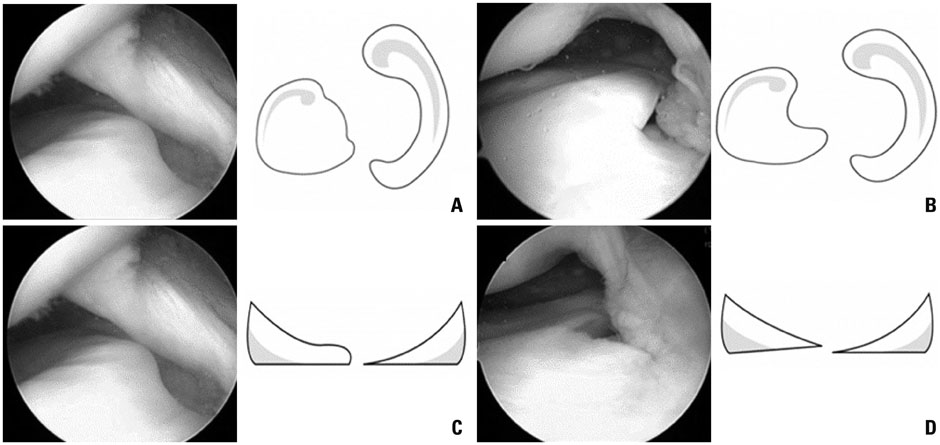Yonsei Med J.
2015 May;56(3):753-759. 10.3349/ymj.2015.56.3.753.
Bilateral Occurrence and Morphologic Analysis of Complete Discoid Lateral Meniscus
- Affiliations
-
- 1Department of Orthopedic Surgery, Ajou University School of Medicine, Suwon, Korea. dr.bhmin@gmail.com
- 2Department of Orthopedic Surgery, Sung Min Hospital, Incheon, Korea.
- 3Department of Molecular Science and Technology, Ajou University, Suwon, Korea.
- KMID: 2450350
- DOI: http://doi.org/10.3349/ymj.2015.56.3.753
Abstract
- PURPOSE
The aim of the study was to investigate and analyze bilateral incidence and morphology of complete discoid lateral meniscus (DLM) with possible relation to tears and symptoms in knee joints.
MATERIALS AND METHODS
Thirty-eight consecutive patients with symptomatic or already-torn complete DLM on magnetic resonance imaging in a unilateral knee underwent diagnostic arthroscopy on both knee joints upon agreement. The presence and shape of complete DLM as well as presence and pattern of tear were recorded accordingly.
RESULTS
In total, 89.5% (34 of 38 patients) showed bilateral complete DLM, and 84.2% yielded bilateralism with identical shape. Cape-slab was the most frequent shape, comprising 68.8% of patients with identically-shaped bilateral DLM overall. Tear patterns were more frequent, in the order of longitudinal, simple horizontal, radial, and degenerative; however, the morphological shape of complete DLM was not significantly related to tear incidence or pattern. Meniscus tears and knee symptoms occurred in the contralateral knee with incidences of 32.4% and 26.5% in patients with bilateral complete DLM, respectively.
CONCLUSION
Based on these findings, more aggressive warning on the presence of discoid pathology and the need for evaluation on the contralateral knee should be considered during consultation with patients with symptomatic complete DLM in a unilateral knee in the outpatient clinic.
Keyword
MeSH Terms
Figure
Reference
-
1. Yaniv M, Blumberg N. The discoid meniscus. J Child Orthop. 2007; 1:89–96.
Article2. Greis PE, Bardana DD, Holmstrom MC, Burks RT. Meniscal injury: I. Basic science and evaluation. J Am Acad Orthop Surg. 2002; 10:168–176.
Article3. Choi CH, Cho SH, Kim JH, Chung HK. Prevalence of lateral discoid meniscus. J Korean Orthop Assoc. 2002; 37:353–356.
Article4. Ikeuchi H. Arthroscopic treatment of the discoid lateral meniscus. Technique and long-term results. Clin Orthop Relat Res. 1982; 19–28.
Article5. Dickason JM, Del Pizzo W, Blazina ME, Fox JM, Friedman MJ, Snyder SJ. A series of ten discoid medial menisci. Clin Orthop Relat Res. 1982; 75–79.
Article6. Nathan PA, Cole SC. Discoid meniscus. A clinical and pathologic study. Clin Orthop Relat Res. 1969; 64:107–113.7. Jeannopoulos CL. Observations on discoid menisci. J Bone Joint Surg Am. 1950; 32-A:649–652.
Article8. Ahn JY, Kim TH, Jung BS, Ha SH, Lee BS, Chung JW, et al. Clinical Results and Prognostic Factors of Arthroscopic Surgeries for Discoid Lateral Menisci Tear: Analysis of 179 Cases with Minimum 2 Years Follow-up. Knee Surg Relat Res. 2012; 24:108–112.
Article9. Rao SK, Sripathi Rao P. Clinical, radiologic and arthroscopic assessment and treatment of bilateral discoid lateral meniscus. Knee Surg Sports Traumatol Arthrosc. 2007; 15:597–601.
Article10. Klingele KE, Kocher MS, Hresko MT, Gerbino P, Micheli LJ. Discoid lateral meniscus: prevalence of peripheral rim instability. J Pediatr Orthop. 2004; 24:79–82.11. Rosenberg TD, Paulos LE, Parker RD, Harner CD, Gurley WD. Discoid lateral meniscus: case report of arthroscopic attachment of a symptomatic Wrisberg-ligament type. Arthroscopy. 1987; 3:277–282.
Article12. Clark CR, Ogden JA. Development of the menisci of the human knee joint. Morphological changes and their potential role in childhood meniscal injury. J Bone Joint Surg Am. 1983; 65:538–547.
Article13. Dickhaut SC, DeLee JC. The discoid lateral-meniscus syndrome. J Bone Joint Surg Am. 1982; 64:1068–1073.
Article14. Jordan MR. Lateral Meniscal Variants: Evaluation and Treatment. J Am Acad Orthop Surg. 1996; 4:191–200.
Article15. Aichroth PM, Patel DV, Marx CL. Congenital discoid lateral meniscus in children. A follow-up study and evolution of management. J Bone Joint Surg Br. 1991; 73:932–936.
Article16. Bellier G, Dupont JY, Larrain M, Caudron C, Carlioz H. Lateral discoid menisci in children. Arthroscopy. 1989; 5:52–56.
Article17. Hart ES, Kalra KP, Grottkau BE, Albright M, Shannon EG. Discoid lateral meniscus in children. Orthop Nurs. 2008; 27:174–179.
Article18. Pellacci F, Montanari G, Prosperi P, Galli G, Celli V. Lateral discoid meniscus: treatment and results. Arthroscopy. 1992; 8:526–530.
Article19. Kato Y, Oshida M, Aizawa S, Saito A, Ryu J. Discoid lateral menisci in Japanese cadaver knees. Mod Rheumatol. 2004; 14:154–159.
Article20. Ahn JH, Lee SH, Yoo JC, Lee HJ, Lee JS. Bilateral discoid lateral meniscus in knees: evaluation of the contralateral knee in patients with symptomatic discoid lateral meniscus. Arthroscopy. 2010; 26:1348–1356.
Article21. Bae JH, Lim HC, Hwang DH, Song JK, Byun JS, Nha KW. Incidence of bilateral discoid lateral meniscus in an Asian population: an arthroscopic assessment of contralateral knees. Arthroscopy. 2012; 28:936–941.
Article22. Hayashi LK, Yamaga H, Ida K, Miura T. Arthroscopic meniscectomy for discoid lateral meniscus in children. J Bone Joint Surg Am. 1988; 70:1495–1500.
Article23. Herwig J, Egner E, Buddecke E. Chemical changes of human knee joint menisci in various stages of degeneration. Ann Rheum Dis. 1984; 43:635–640.
Article24. Kim SJ, Kim DW, Min BH. Discoid lateral meniscus associated with anomalous insertion of the medial meniscus. Clin Orthop Relat Res. 1995; 234–237.
Article25. Rohren EM, Kosarek FJ, Helms CA. Discoid lateral meniscus and the frequency of meniscal tears. Skeletal Radiol. 2001; 30:316–320.
Article26. Cui JH, Min BH. Collagenous fibril texture of the discoid lateral meniscus. Arthroscopy. 2007; 23:635–641.
Article27. Stark JE, Siegel MJ, Weinberger E, Shaw DW. Discoid menisci in children: MR features. J Comput Assist Tomogr. 1995; 19:608–611.28. Bin SI, Kim JC, Kim JM, Park SS, Han YK. Correlation between type of discoid lateral menisci and tear pattern. Knee Surg Sports Traumatol Arthrosc. 2002; 10:218–222.
Article


